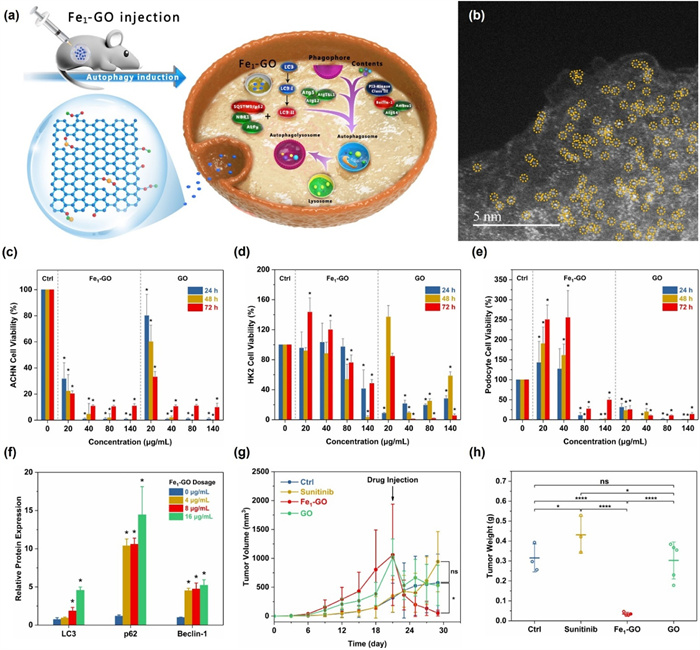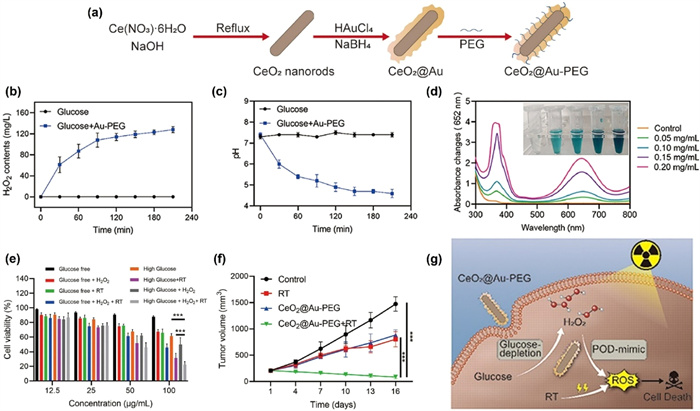-
[1]
R.M. Carey, H.M. Siragy, Trends Endocrin. Met. 14 (2003) 274–281.
-
[2]
F. Bray, M. Laversanne, H. Sung, et al., CA-Cancer J. Clin. 74 (2024) 229–263.
doi: 10.3322/caac.21834
-
[3]
X. Wang, L. Yang, Z. Chen, et al., CA-Cancer J. Clin. 58 (2008) 97–110.
doi: 10.3322/CA.2007.0003
-
[4]
J.S. Lam, O. Shvarts, J.T. Leppert, et al., J. Urol. 174 (2005) 466–472.
doi: 10.1097/01.ju.0000165572.38887.da
-
[5]
K. Gupta, J.D. Miller, J.Z. Li, et al., Cancer Treat. Rev. 34 (2008) 193–205.
-
[6]
T. Powles, E.R. Plimack, D. Soulières, et al., Lancet Oncol. 21 (2020) 1563–1573.
-
[7]
J. Bedke, L. Albiges, U. Capitanio, et al., Eur. Urol. 81 (2022) 134–137.
-
[8]
Y. Huang, J. Wang, K. Jiang, et al., J. Control. Release 334 (2021) 127–137.
-
[9]
H. Pavenstädt, W. Kriz, M. Kretzler, Physiol. Rev. 83 (2003) 253–307.
doi: 10.1152/physrev.00020.2002
-
[10]
C.P. Liu, Y. Hu, J.C. Lin, et al., Med. Res. Rev. 39 (2019) 561–578.
doi: 10.1002/med.21532
-
[11]
R.M. Williams, J. Shah, H.S. Tian, et al., Hypertension 71 (2018) 87–94.
-
[12]
W. Song, S.N. Musetti, L. Huang, Biomaterials 148 (2017) 16–30.
-
[13]
Y. Liu, X. Wang, M. Hussain, et al., Med. Sci. 6 (2018) 100.
-
[14]
N. Ahmed, H. Fessi, A. Elaissari, Drug Discov. Today 17 (2012) 928–934.
-
[15]
S.S. Das, P. Bharadwaj, M. Bilal, et al., Polymers 12 (2020) 1397.
doi: 10.3390/polym12061397
-
[16]
M.H. He, L. Chen, T. Zheng, et al., Front. Pharmacol. 9 (2018) 745.
-
[17]
J. Li, K. Wu, J. Zhang, et al., Biomed. Pharmacother. 167 (2023) 115444.
-
[18]
Z. Qian, Y. Zhang, J. Yuan, et al., Front. Bioeng. Biotech. 11 (2023) 1111977.
-
[19]
R. Wu, K. Wang, Y. Gai, et al., J. Nanobiotechnol. 21 (2023) 3.
-
[20]
D. Maiti, X. Tong, X. Mou, et al., Front. Pharmacol. 9 (2019) 1401.
-
[21]
P.K. Jiwanti, B.Y. Wardhana, L.G. Sutanto, et al., Molecules 27 (2022) 7578.
doi: 10.3390/molecules27217578
-
[22]
M. Shin, J. Lim, Y. Park, et al., RSC Adv. 14 (2024) 7142–7156.
doi: 10.1039/d3ra08946k
-
[23]
B. Han, Y.L. Zhang, Q.D. Chen, et al., Adv. Funct. Mater. 28 (2018) 1802235.
-
[24]
S.V. Torti, F. Byrne, O. Whelan, et al., Int. J. Nanomed. 2 (2007) 707–714.
-
[25]
A. Burke, X. Ding, R. Singh, et al., Proc. Natl. Acad. Sci. U. S. A. 106 (2009) 12897–12902.
doi: 10.1073/pnas.0905195106
-
[26]
J. Li, J. Wang, D. Sun, et al., J. Biomed. Nanotechnol. 12 (2016) 1604–1616.
doi: 10.1166/jbn.2016.2271
-
[27]
Z. Jiang, H. Jin, S. Sun, et al., Mat. Sci. Eng. C: Mater. 93 (2018) 846–852.
-
[28]
R. Jia, T. Li, W. Jiang, et al., Mater. Design 224 (2022) 111287.
-
[29]
Y. Zhou, K. Ma, J. Liu, et al., Chin. Chem. Lett. 35 (2024) 109056.
-
[30]
L. Wang, P. Yin, Z. Jing, et al., Surf. Interfaces 46 (2024) 104147.
-
[31]
J.J. Xu, W.C. Zhang, Y.W. Guo, et al., Drug Deliv. 29 (2022) 664–678.
-
[32]
R. Khursheed, K. Dua, S. Vishwas, et al., Biomed. Pharmacother. 150 (2022) 112951.
-
[33]
R.N. Pedro, T. Thekke-Adiyat, R. Goel, et al., Urology 76 (2010) 494–498.
-
[34]
S. Nikzad, G. Mahmoudi, P. Amini, et al., J. Renal Inj. Prev. 6 (2016) 103–108.
doi: 10.15171/jrip.2017.20
-
[35]
C. Callaghan, D. Peralta, J. Liu, et al., J. Pharm. Sci. 105 (2016) 284–292.
-
[36]
J. Liu, C. Abshire, C. Carry, et al., BJU Int. 119 (2017) 342–348.
doi: 10.1111/bju.13590
-
[37]
R. Liu, Q. Pei, T. Shou, et al., Int. J. Nanomed. 14 (2019) 4091–4103.
doi: 10.2147/ijn.s203222
-
[38]
E.J. Nam, S.K. Kong, I. Cho, et al., J. Drug Deliv. Sci. Tec. 91 (2024) 105179.
-
[39]
P. Zhao, X. Chen, Q. Wang, et al., Nanomedicine 15 (2020) 1079–1096.
doi: 10.2217/nnm-2019-0417
-
[40]
S.A. Read, S. Obeid, C. Ahlenstiel, et al., Adv. Nutr. 10 (2019) 696–710.
doi: 10.1093/advances/nmz013
-
[41]
S. Hameed, J. Iqbal, M. Ali, et al., Mater. Res. Express 6 (2019) 102005.
doi: 10.1088/2053-1591/ab40df
-
[42]
S. El-Sonbaty, E.I. Kandil, R.A.H. Haroun, Biol. Trace Elem. Res. 201 (2023) 272–281.
doi: 10.1007/s12011-022-03126-5
-
[43]
J. Chen, F. Ren, W. Cao, et al., Nanomedicine: NBM 34 (2021) 102370.
-
[44]
C. Li, P. Zhu, H. Xiang, et al., Mater. Today Bio. 18 (2023) 100513.
-
[45]
J. Cheng, W. Wan, W. Zhu, Chin. J. Chem. 34 (2016) 53–58.
doi: 10.1002/cjoc.201500339
-
[46]
C. Yang, Y. Zhu, D. Li, et al., Small 17 (2021) e2101837.
-
[47]
M.P. Vinardell, M. Mitjans, Nanomaterials 5 (2015) 1004–1021.
doi: 10.3390/nano5021004
-
[48]
X. Wang, D. Li, Z. Xia, et al., Arab. J. Chem. 15 (2022) 103753.
doi: 10.1016/j.arabjc.2022.103753
-
[49]
X. Zhou, T. Cao, J. Oncol. 2022 (2022) 2883404.
-
[50]
A. Grillone, E.R. Riva, A. Mondini, et al., Adv. Healthc. Mater. 4 (2015) 1681–1690.
doi: 10.1002/adhm.201500235
-
[51]
M.V. Yigit, A. Moore, Z. Medarova, Pharm. Res. 29 (2012) 1180–1188.
doi: 10.1007/s11095-012-0679-7
-
[52]
A. Takke, P. Shende, Life Sci. 275 (2021) 119377.
-
[53]
A. Takke, P. Shende, Colloid Surface A 628 (2021) 127349.
-
[54]
T.V.M. Sreekanth, M. Pandurangan, G.R. Dillip, et al., J. Photoch. Photobio. B 164 (2016) 174–181.
-
[55]
Q. Yang, Y. Wang, Q. Yang, et al., Biomaterials 146 (2017) 72–85.
-
[56]
M. Shi, S. Wang, S. Zheng, et al., Colloid Surface B 185 (2020) 110625.
-
[57]
L. Lei, K. Wang, Int. J. Nanomed. 19 (2024) 699–707.
doi: 10.2147/ijn.s415668
-
[58]
Z.X. Wang, Y. Hou, W. Han, et al., Chem. Res. Chinese U. 27 (2011) 94–98.
-
[59]
L. Gao, Y.Z. Fan, T.H. Zhang, et al., RSC Adv. 9 (2019) 11567–11575.
doi: 10.1039/c9ra01029g
-
[60]
H. Jiang, R. Wang, F. Zhou, et al., Int. J. Biol. Macromol. 211 (2022) 35–46.
-
[61]
Y. Lang, X. Tian, H.Y. Dong, et al., Cells 11 (2022) 1651.
doi: 10.3390/cells11101651
-
[62]
B. Yang, Y. Chen, J. Shi, Adv. Mater. 31 (2019) 1901778.
-
[63]
X. Qian, J. Zhang, Z. Gu, et al., Biomaterials 211 (2019) 1–13.
doi: 10.1155/2019/7362931
-
[64]
W. Cao, M. Jin, K. Yang, et al., J. Nanobiotechnol. 19 (2021) 325.
-
[65]
C. Jia, Y. Guo, F.G. Wu, Small 18 (2022) 2103868.
-
[66]
Q. Zhou, S. Shao, J. Wang, et al., Nat. Nanotechnol. 14 (2019) 799–809.
doi: 10.1038/s41565-019-0485-z
-
[67]
A. Zhang, K. Meng, Y. Liu, et al., Adv. Colloid Interface Sci. 284 (2020) 102261.

 Login In
Login In







 DownLoad:
DownLoad:





